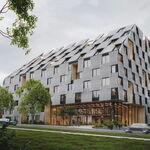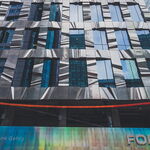Another advantage of having signals on the near-side only is that it allows for more precise all-way-red calculations which provide less all-red time without compromising safety. That's because of the way near-side-only signals automatically enforce the correct stopping position.
Take for example King & Sumach, which has enormous all-red times due to its awkward configuration and our primitive Ontario clearance calculations. For example, I'll look at the clearance time between the east-west phase and the northbound only phase which usually follows it.
East-west movements (terminating) shown in red, northbound movements (starting) shown in green:
In Ontario, the all-red time is simply the longest time it takes any of the terminating movements to clear a conflicting starting movement (or become effectively parallel with it). In this example, the critical movement is the eastbound curb lane, which has 35 metres between the stop bar and the point where it's nearly parallel with the northbound left turn movement. As per the standard Ontario calculation for a 40km/h zone, the all-red for this particular phase transition is therefore 3.7 seconds.
But once the northbound phase starts, it's still a few seconds before those cars actually reach the intersection, because the stop bar is so far back. That means there's wasted time where people are kept waiting unnecessarily.
Northbound traffic covers 28.5 metres before it conflicts with east-west vehicle traffic traffic.* At the 40 km/h, that takes 2.6 seconds.** So
if we can be sure cars are actually stopped behind the stopbar we can give northbound traffic a 2.6-second head start to account for this, which leaves an east-west all-red time of 1.1 seconds. That's
less than half the all-red time which would be required if we didn't account for the start-up time of the following phase (and in fact, this movement has a 5-second all-red, because the signal doesn't actually know which phase will come up next and therefore we need to design for clearing the entire intersection, not just the following movement). Saving 2 or 3 seconds during the phase transition is a huge deal when you consider that the northbound green can be as short as 7 seconds.
But in Ontario, our far-side signals mean that we cannot use this reduction factor, because there is a very real possibility that someone stops too far forward and therefore takes less time than we calculated to reach the intersection after the start of green. If there were only near-side signals, that wouldn't an issue because if a car stops too far forward, the driver can't see the signals anyway.
_
* Terminating pedestrian movements are not considered in all-red calculations because the countdown will have already reached zero before the start of yellow. But starting pedestrian pedestrian movements
are considered, since the Walk starts at the same time as the Green. In this case, the northbound phase has no pedestrian movements associated with it (the north-south pedestrian crossing runs with the southbound phase).
**Obviously in practice it would take considerably longer than this for cars to reach that point due to reaction times, acceleration time and turning speeds, but we need to design for this situation because it's legally possible for someone to cross the stopbar at 40km/h the instant the light turns green and continue through the intersection at that speed.
Note that despite the above, I don't think we should switch to near-side signals - it's a matter of cost. It would take billions if not trillions of dollars to convert every traffic signal in North America to near-side-only, given the number of signals and the cost of pole and utility relocation.








